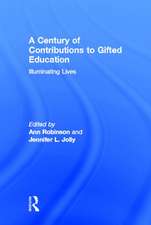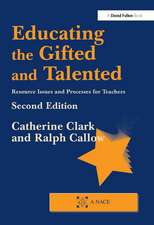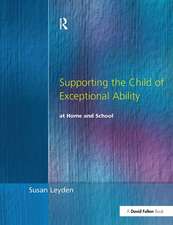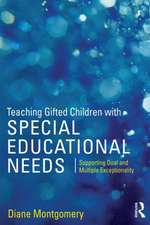The Underachieving Gifted Child: Recognizing, Understanding, and Reversing Underachievement (A CEC-TAG Educational Resource)
Autor Del Siegleen Limba Engleză Paperback – oct 2012
Preț: 157.58 lei
Preț vechi: 182.97 lei
-14% Nou
Puncte Express: 236
Preț estimativ în valută:
30.15€ • 31.42$ • 24.97£
30.15€ • 31.42$ • 24.97£
Carte tipărită la comandă
Livrare economică 04-18 aprilie
Preluare comenzi: 021 569.72.76
Specificații
ISBN-13: 9781593639563
ISBN-10: 1593639562
Pagini: 192
Dimensiuni: 152 x 229 x 51 mm
Greutate: 0.92 kg
Ediția:1
Editura: Taylor & Francis
Colecția Routledge
Locul publicării:Oxford, United Kingdom
ISBN-10: 1593639562
Pagini: 192
Dimensiuni: 152 x 229 x 51 mm
Greutate: 0.92 kg
Ediția:1
Editura: Taylor & Francis
Colecția Routledge
Locul publicării:Oxford, United Kingdom
Public țintă
Professional Practice & DevelopmentCuprins
Acknowledgments Chapter 1 Introduction Chapter 2 What Is Underachievement? Chapter 3 Characteristics of Underachievers Chapter 4 Dweck’s Mindsets: Recognizing Effort and Ability Chapter 5 Addressing Issues of Perfectionism Chapter 6 Rimm’s Trifocal Model Chapter 7 Achievement Orientation Model: Students’ Beliefs That Regulate Their Motivation to Achieve Chapter 8 Self-Efficacy: Increasing Students’ Confidence to Learn Chapter 9 Goal Valuation: Making Learning More Meaningful Chapter 10 Environmental Perceptions: Building Trust Relationships Chapter 11 Developing Self-Regulation and Study Skills Chapter 12 Putting It All Together References Appendix The National Association for Gifted Children’s Position Paper on Giftedness About the Author
Notă biografică
Del Siegle, Ph.D., is an associate professor and teaching fellow in the Neag School of Education at the University of Connecticut, where he teaches graduate courses in gifted education, creativity, and research design. He is president of the National Association of Gifted Children and also serves on the board of directors of The Association for the Gifted (CEC-TAG). He authors a technology column for Gifted Child Today. Siegle's research interests include Web-based instruction, student motivation, and teacher bias in the identification of students for gifted programs. He currently serves as the coeditor of the Journal of Advanced Academics.
Descriere
Why are some gifted children willing to tackle new challenges whereas others seem insecure or uninterested? Why do some gifted students achieve while others become caught in a cycle of underachievement? Are there strategies teachers and parents can implement that promote an achievement-oriented attitude? The Underachieving Gifted Child: Recogniz














